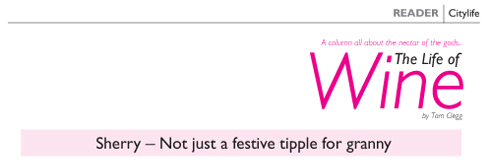
A disturbing number of people I have asked about sherry have replied something along the lines of it reminds them of kissing granny at Christmas. In fact, most articles about this most misunderstood of wines have some mention of a granny in them. So this month: Sherry – it’s not all about grandmothers.
Sherry, a bit like grannies, I suppose, comes in a number of styles and varieties. It can be sweet, velvety and elegant, but it can also be sharp, tangy and bone-dry. The vast majority of this fortified wine is made in the latter style. Because of this, it’s Fino and Manzanilla I wish to talk about. This stunning drink is so far removed from the muddy gunk many people have vowed never to touch again because of a bad experience with the dregs of a five-year-old bottle of Bristol Cream they found in a drinks cabinet when they were 14.
The best Fino and Manzanilla should be up there with the finest champagnes, if only because the process of producing the wine shows such ingenuity. Made from the Palomino grape the wine is fortified with a dose of spirit which results in its alcohol content hovering around 15 per cent. This allows something remarkable to happen, which only really occurs around Jerez in Spain (the English bastardised the name to sherry). A gunky, yeasty layer forms on the top of the wine which protects it from various bacteria, and more importantly, the harmful effects of oxygen. This produces a wine which beneath the porridge is extremely fresh and delicate.
Then there is the solera system which is the way in which the newer casks of sherry are blended with older wines. Picture a pyramid of oak barrels, as many as 100, all holding different vintages of wine. The oldest casks are at the bottom. Around a third of the sherry is taken from these older barrels and bottled. The third that has been taken is then replaced by a portion from barrels above which in turn are refilled from the barrels above them, and so on. This means that the taste of the wine remains consistent and that there is, in theory, at least a fraction of the very oldest wine going into each bottle produced. Mind blowing, eh?
Getting this right takes an enormous amount of skill and is just one of the reasons why sherry deserves its position as one of the finest tipples performing on the world’s wine stage.
Sherry’s popularity went into decline not because it was labelled a granny tipple, and not because so many already opened bottles in the drinks cabinet made their way into the hands of experimentative 14-year-olds, but because of the perception that it was terribly high in alcohol. However at 15 per cent (an EU stipulation, by the way) is a bottle of Fino or Manzanilla actually that much stronger than most new world wines making their way onto the dinner table? If Brussels got its grubby hands off sherry, it could easily be produced at lower alcohol levels.
Sherry needs to be reassessed. Many wine writers seem desperate to extol its virtues. However, its lack of popularity with consumers means that, for the time being, the price of some truly exceptional bottles is being kept thankfully lower than they deserve. So, as far as I’m rather selfishly concerned, sherry should always remind the majority of snogging granny during the festive season. But for those looking for something that will truly astonish, slosh some Fino into a decent sized glass and treat it like any other brilliant still wine.
Perfect with a bit of salty Thai tapas, by the way.
CityWine is the new wine initiative by Citylife. During the last quarter of 2010 and the beginning of 2011, CityWine organised a number of wine-focussed events supporting local establishments while stocking up the wine fridges of many wine buyers at well under retail prices.
CityWine welcomes your feedback and suggestions for future events, tastings or anything wine related. Send your correspondence to janjira@chiangmaicitylife.com or visit www.city-wine.com.